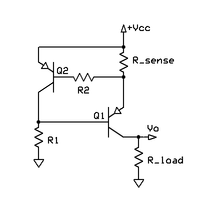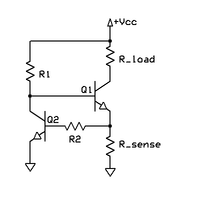Current limiting
Current limiting is the practice in electrical or electronic circuits of imposing an upper limit on the current that may be delivered to a load with the purpose of protecting the circuit generating or transmitting the current from harmful effects due to a short-circuit or similar problem in the load.
Inrush current limiting
An inrush current limiter is a device or group of devices used to limit inrush current. Negative temperature coefficient (NTC) thermistors and resistors are two of the simplest options, with cool-down time and power dissipation being their main drawbacks, respectively. More complex solutions can be used when design constraints make simpler options impractical.
In electronic power circuits

Some electronic circuits employ active current limiting, since a fuse may not protect solid-state devices.
One style of current limiting circuit is shown in the image. The schematic is representative of a simple protection mechanism used in regulated DC supplies and class-AB power amplifiers.[lower-alpha 1]
Q1 is the pass or output transistor. Rsens is the load current sensing device. Q2 is the protection transistor which turns on as soon as the voltage across Rsens becomes about 0.65 V. This voltage is determined by the value of Rsens and the load current through it (Iload). When Q2 turns on, it removes base current from Q1 thereby reducing the collector current of Q1. which is very nearly the load current. Thus, Rsens fixes the maximum current to a value given by 0.65/Rsens. For example, if Rsens = 0.33 Ω, the current is limited to about 2 A even if Rload becomes a short (and Vo becomes zero).
Further, this power dissipation will remain as long as the overload exists, which means that the devices must be capable of withstanding it for a substantial period. This power dissipation will be substantially less than if no current limiting circuit had been provided. In this technique, beyond the current limit the output voltage will decrease to a value depending on the current limit and load resistance.
- For class-AB stages, the circuit will be mirrored vertically and complementary devices will be used for Q1 & Q2.
Single power-supply circuits


An issue with the previous circuit is that Q1 will not be saturated unless its base is biased about 0.5 volts above Vcc.
The circuits at right and left operate more efficiently from a single (Vcc) supply. In both circuits, R1 allows Q1 to turn on and pass voltage and current to the load. When the current through R_sense exceeds the design limit, Q2 begins to turn on, which in turn begins to turn off Q1, thus limiting the load current. The optional component R2 protects Q2 in the event of a short-circuited load. When Vcc is at least a few volts, a MOSFET can be used for Q1 for lower dropout voltage. Due to its simplicity, this circuit is sometimes used as a current source for high-power LEDs.[1]
Slew rate control
Many electronics designers put a small resistor on IC output pins.[2] This slows the edge rate which improves electromagnetic compatibility. Some devices have this "slew rate limiting" output resistor built in; some devices[3][4][5][6] have programmable slew rate limiting. This provides overall slew rate control.
References
- "The New Stuff!!! Constant Current Source #1". Instructables. Retrieved 4 July 2012.
- IC output series resistor
- Freescale MC9S12XHZ512
- Microchip PIC18F87J50
- Initio INIC-940 Archived October 18, 2006, at the Wayback Machine
- Fairchild FDC6901L
External links
- Current Limiting for Stepper Motors
- Current limiting resistor calculator for LED arrays
- Constant current & foldback current limiting